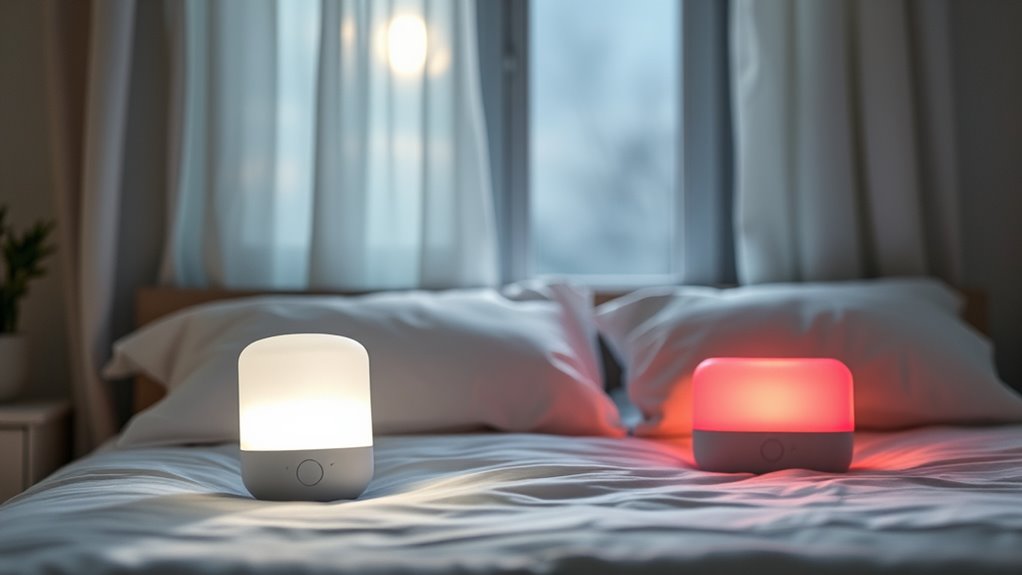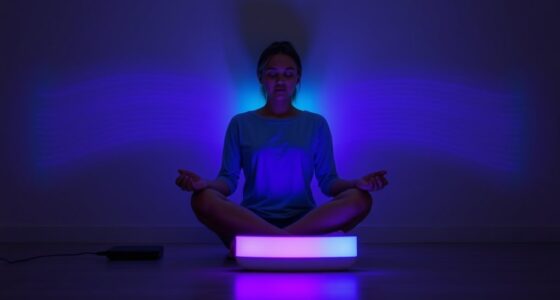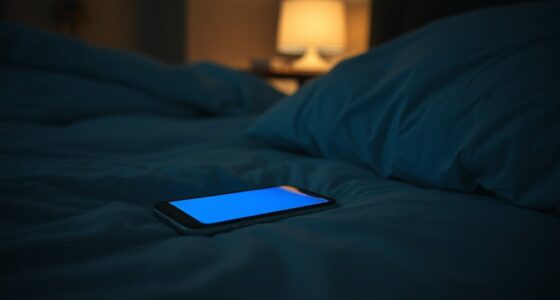Choosing between white noise and pink noise for sleep depends on your preferences and needs. White noise offers a consistent, broad spectrum that masks disruptive sounds, helping you fall asleep faster. Pink noise provides a gentler, more natural sound with emphasis on lower frequencies, promoting deeper, restorative rest. Both can improve sleep quality, but your ideal choice might vary. If you want to discover how each type can best suit your sleep habits, there’s more to explore ahead.
Key Takeaways
- White noise provides a broad, consistent spectrum that masks all sounds, ideal for blocking environmental disturbances during sleep.
- Pink noise emphasizes lower frequencies, creating a softer, more relaxing environment that supports deeper, restorative sleep.
- Personal preference influences effectiveness; some find pink noise more soothing, while others prefer white noise for masking.
- Pink noise may promote better deep sleep due to its calming, natural sound profile, whereas white noise can be more stimulating or harsh for sensitive sleepers.
- Experimentation with volume and type helps determine which noise best enhances individual sleep quality and comfort.
Understanding White Noise and Pink Noise
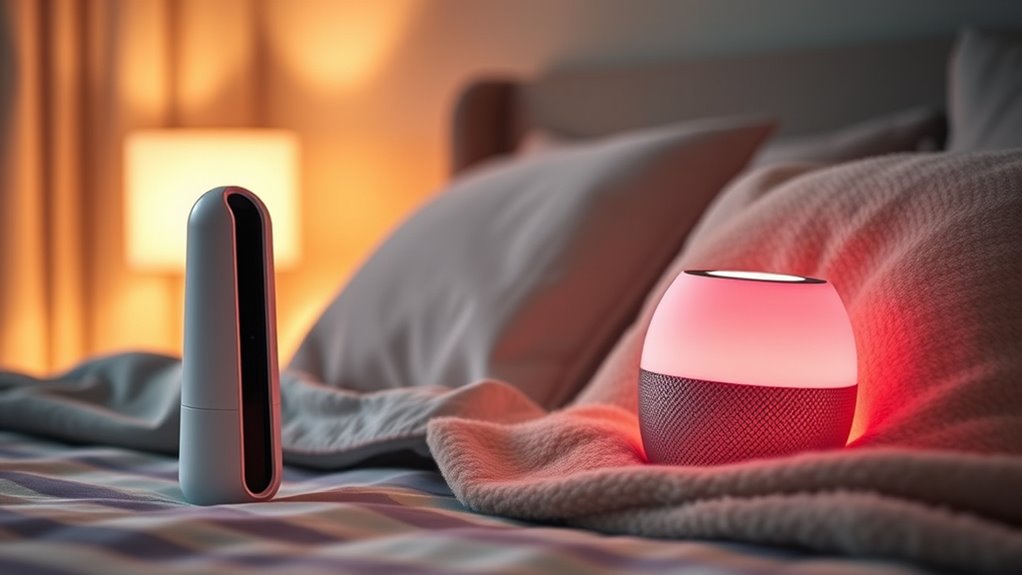
To understand the difference between white noise and pink noise, it’s important to know what each type sounds like and how they behave. White noise contains a consistent frequency modulation, meaning all audio frequencies are played at equal intensity, creating a static-like sound. This uniformity helps with acoustic masking by covering up other sounds, making it useful for sleep or focus. Pink noise, on the other hand, has a natural decline in intensity as frequencies increase, resulting in a more balanced, soothing sound. Its frequency modulation reduces sharp high tones, which enhances acoustic masking without being overwhelming. By understanding these sound characteristics, you can better select the noise type that most effectively masks disruptive sounds and suits your personal preferences for relaxation or sleep. Additionally, understanding the sound spectrum can help you choose the most effective noise type for your needs.
The Science Behind Sound Frequencies
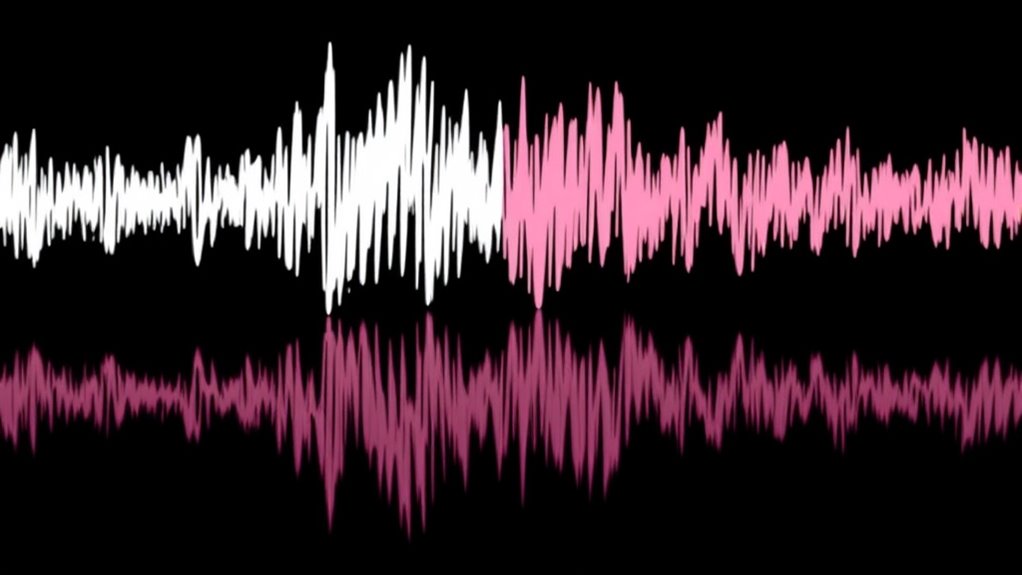
Sound frequencies cover a wide range, affecting your brain and body in different ways. You might notice how specific frequencies can help you relax or stay alert through brainwave entrainment. Understanding these ranges and effects reveals how white and pink noise mask sounds and influence your mental state.
Sound Frequency Ranges
Understanding sound frequency ranges helps you grasp how different noises—like white and pink—affect your perception and environment. The sound spectrum covers a wide range of frequency ranges, from deep lows to high pitches. White noise contains equal energy across all frequencies, resulting in a broad sound spectrum that can mask other sounds effectively. Pink noise, however, emphasizes lower frequencies, with energy decreasing as the frequency increases, producing a more balanced and mellow sound. This variation in frequency ranges influences how your brain processes these noises, affecting relaxation and sleep quality. Additionally, sound frequency ranges can impact how your brain perceives and responds to different noises, making it easier to select the most suitable sound for your needs. By understanding these differences, you can better choose the type of noise that suits your needs, whether you prefer the consistent full-spectrum sound of white noise or the more natural, soothing qualities of pink noise.
Brainwave Entrainment Effects
Brainwave entrainment occurs when specific sound frequencies influence your brain’s electrical activity, encouraging it to synchronize with external rhythms. This process is a key aspect of sound therapy, aimed at promoting relaxation, focus, or sleep. When you listen to carefully calibrated tones or rhythms, your brain’s electrical signals begin to align with those frequencies, shifting your mental state. For example, binaural beats or rhythmic sounds can guide your brain into alpha or theta waves, which are associated with relaxation and deep sleep. This synchronization enhances your ability to relax and reduces stress. Brainwave entrainment leverages the power of sound therapy to create a calming environment, making it easier for you to unwind and achieve restful sleep. Additionally, some studies suggest that combining sound therapy with eye patches or other relaxation techniques can further improve sleep quality.
Auditory Masking Benefits
Auditory masking works by using specific sound frequencies to cover or diminish unwanted noises, making it easier for you to focus or relax. When you choose the right soundscape, it can substantially improve your ambient acoustics, creating a calming environment. Selecting the appropriate soundscapes often involves considering the frequency content that effectively masks disruptive sounds. Pink noise, with its balanced spectrum, can blend seamlessly into your surroundings, enhancing masking benefits. Here’s a quick comparison:
| Feature | Effect on Masking |
|---|---|
| Soundscapes Selection | Critical for optimizing ambient acoustics |
| Frequency Range | Determines how well noise is masked |
| Noise Type | Pink noise offers smoother masking |
How White Noise Affects Sleep
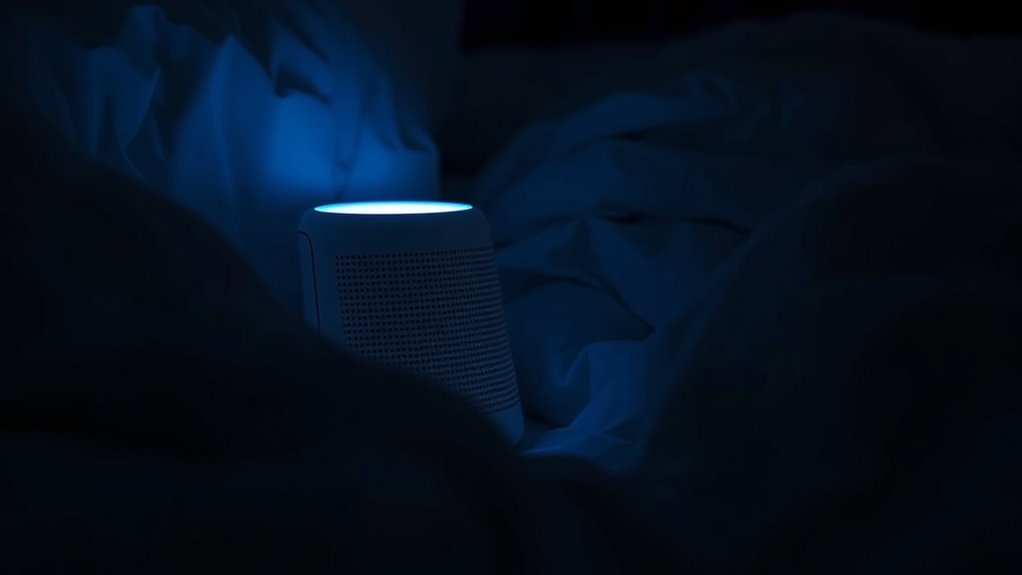
Have you ever noticed how white noise can help you fall asleep faster? It works by creating a consistent sound that masks disruptive noises, making your sleep environment more stable. This is the basis of white noise therapy, which many find effective for reducing nighttime awakenings. White noise’s broad spectrum covers all frequencies, helping to drown out sudden sounds like traffic or voices. As a result, your brain can relax more easily, easing the changeover into sleep. Regular use can condition your mind to associate the sound with sleep, improving overall sleep quality. White noise acts as a simple yet powerful tool to enhance your sleep environment, making it easier to fall asleep and stay asleep through the night. Additionally, some sound therapy options include pink noise, which many users find even more soothing for prolonged sleep periods.
The Impact of Pink Noise on Restorative Sleep

Unlike white noise, pink noise is known for its soothing, balanced sound that many find particularly beneficial for restorative sleep. It creates a calming sleep environment by reducing abrupt sound fluctuations, helping you stay asleep longer. Your noise preferences play a big role in how effectively pink noise enhances sleep quality. To better understand, consider this table:
| Aspect | Effect on Sleep | Best For |
|---|---|---|
| Sound quality | Gentle, smooth sound | Deep relaxation |
| Noise spectrum | Equal energy across octaves | Consistent sleep environment |
| Sleep stage impact | Promotes REM and slow-wave sleep | Restorative sleep |
| Personal preference | Less harsh than white noise | Sensitive sleepers |
| Usage duration | Effective during entire night | Long-term sleep improvement |
Pink noise’s balanced sound can improve your sleep quality by aligning with your noise preferences and creating a tranquil sleep environment. Understanding the spectrum of pink noise helps explain why it is often more soothing than white noise.
Comparing Benefits for Different Sleep Needs
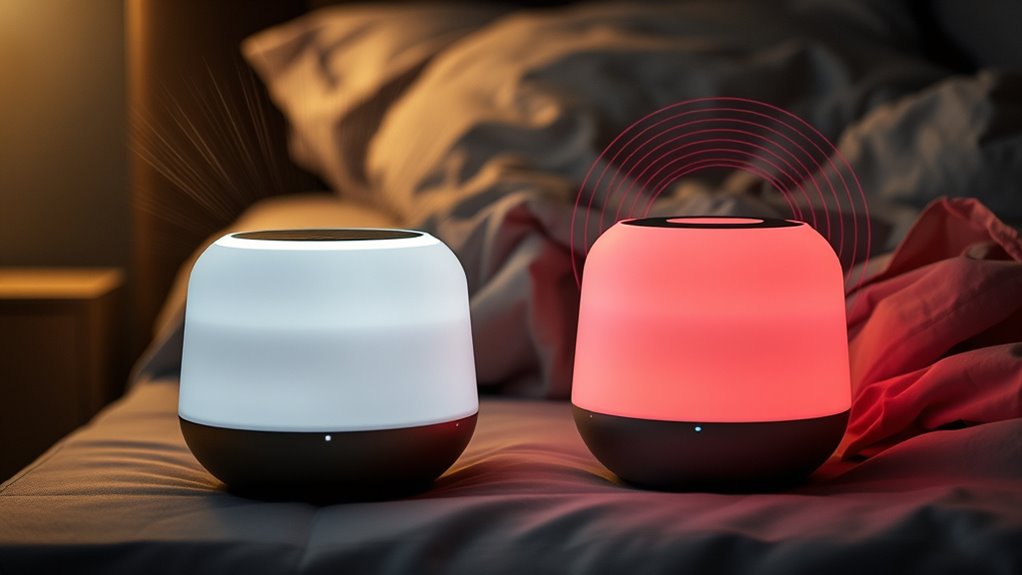
Your sleep needs vary, so it’s important to choose the sound environment that supports your rest best. White noise might help those who struggle with light sleep, masking background sounds effectively. Meanwhile, pink noise can promote deeper, more restorative sleep for those seeking to enhance their overall sleep quality. Understanding fan culture can also offer insights into how communal experiences influence relaxation and sleep environments.
Suitability for Light Sleep
When it comes to light sleep, choosing the right noise can make a significant difference in how restful your experience is. Both white and pink noise can help create ambient comfort by masking sudden sounds that might disturb you. White noise, with its consistent high-frequency sounds, effectively reduces noise levels and promotes a calm environment. Pink noise, with its balanced spectrum, offers a softer, more natural background that many find less intrusive. For light sleep, pink noise often feels gentler, helping you stay relaxed without feeling overwhelmed. However, if you prefer a more uniform sound environment, white noise might be better suited. Ultimately, your comfort depends on your sensitivity to sound frequencies, but both can enhance ambient comfort for lighter sleep stages. Understanding sound spectra can further help you choose the best option for your sleep needs.
Enhancing Deep Rest
Have you ever wondered which type of noise best promotes deep, restorative sleep? Both white and pink noise can support deep rest through sound therapy, but their effectiveness depends on your needs. White noise offers broad frequency modulation, masking disturbances and creating a steady environment. Pink noise, with its emphasis on lower frequencies, may better promote deep sleep by calming the nervous system. Consider this comparison:
| Feature | White Noise | Pink Noise |
|---|---|---|
| Frequency Range | Broad spectrum | Emphasizes lower frequencies |
| Effectiveness for Deep Sleep | Good for masking sounds | Enhances relaxation |
| Sound Therapy Use | Suitable for sleep initiation | Better for deep, restorative sleep |
Choosing the right noise depends on your sleep needs, helping you optimize deep rest. Additionally, understanding how sound frequencies influence sleep quality can guide you in selecting the most beneficial sound environment.
Potential Drawbacks and Limitations

Despite their popularity, both white noise and pink noise have limitations that can affect their effectiveness. For example, using background noise as sound therapy might lead to dependence, making it difficult to fall asleep without it. Some people find white noise too harsh or high-pitched, which can cause irritation or discomfort. Pink noise, while softer, may not be loud enough for everyone or might be drowned out by other environmental sounds. Additionally, continuous exposure to these sounds can potentially mask important sounds, like alarms or safety signals. Not everyone responds positively to sound therapy, and in some cases, it can interfere with sleep cycles or cause distraction. Recognizing these limitations helps you decide if background noise is truly beneficial for your sleep environment. Incorporating knowledge about Glycolic Acid benefits can also remind us that not all solutions work equally well for everyone, emphasizing the importance of personalized approaches.
Choosing the Right Sound for Your Sleep Environment
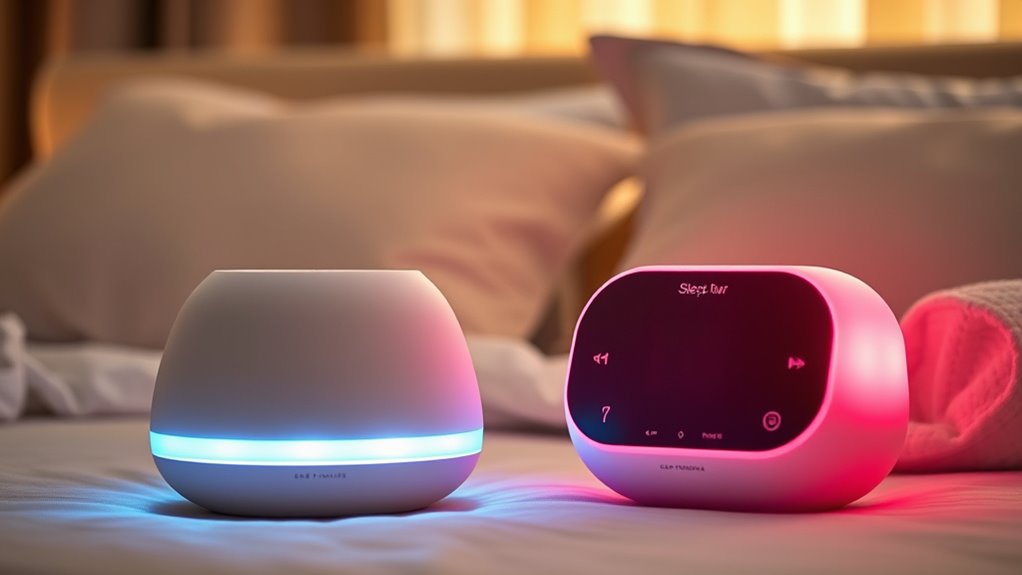
Choosing the right sound for your sleep environment depends on your personal preferences and specific needs. Sound therapy can help you create a calming atmosphere that promotes better sleep and supports good sleep hygiene. If you find white noise soothing, it may help mask disruptive sounds and create a consistent auditory backdrop. Pink noise, with its softer, more natural qualities, might feel more relaxing for others. Consider experimenting with both to see which improves your sleep quality. Guarantee the volume is comfortable and not disruptive. Your goal is to establish a consistent sound environment that signals your brain it’s time to rest. Incorporating principles from sound healing science can deepen your understanding of how specific frequencies influence your relaxation. Ultimately, selecting the right sound enhances your sleep routine and helps you wake feeling more refreshed.
Tips for Incorporating Noise Machines Into Your Bedtime Routine
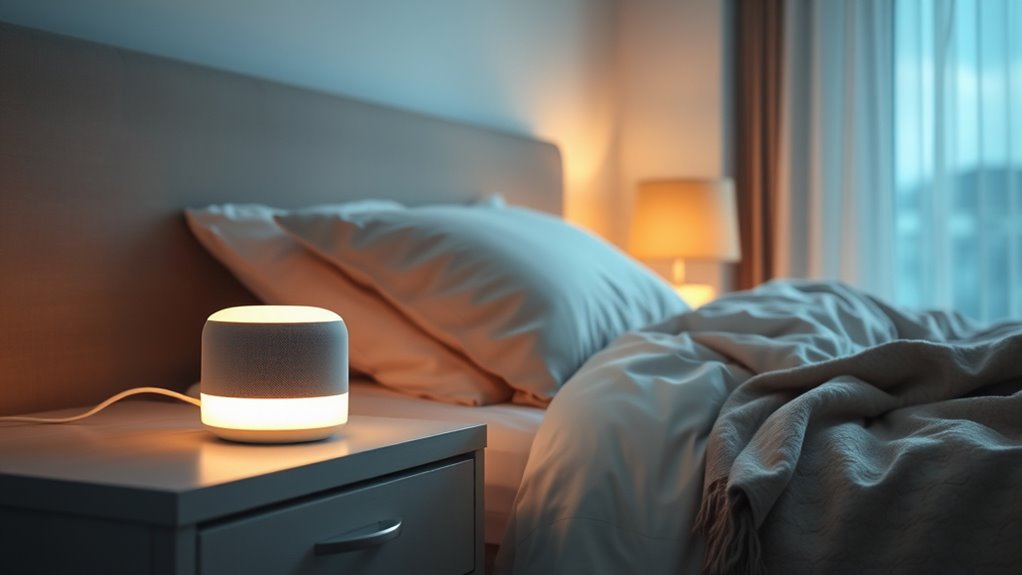
Incorporating noise machines into your bedtime routine can be a straightforward way to create a consistent sleep environment. To maximize benefits, pay attention to noise machine placement—place it away from your pillow to avoid direct sound exposure. Use volume control strategies to find a comfortable level that masks disruptive noises without becoming overwhelming. Experiment with different settings until you find what works best for you. Consider the following tips:
| Tip | Explanation |
|---|---|
| Suitable placement | Keep the machine at a distance from your head for even sound. |
| Start low, increase gradually | Adjust volume slowly until it becomes soothing. |
| Consistent timing | Use the noise machine at the same time each night for routine. |
| Use timers if needed | Set a timer to turn off after you fall asleep. |
| Avoid sudden volume changes | Maintain a steady sound to prevent awakening. |
Frequently Asked Questions
Can White or Pink Noise Help With Insomnia Caused by Anxiety?
If you’re struggling with insomnia caused by anxiety, both white and pink noise can help improve your sleep environment. These sounds promote relaxation techniques that calm your mind, making it easier to fall asleep. Pink noise, in particular, is gentler and more soothing, which may benefit your relaxation. Experiment with both to see which best creates a peaceful sleep environment, helping reduce anxiety and improve your sleep quality.
Are There Specific Sound Frequencies Within White or Pink Noise That Improve Sleep Quality?
Ever wonder if certain sound frequencies could turn your sleep from a nightmare into a dream? In fact, specific frequencies within white or pink noise, thanks to frequency modulation, can target your sound spectrum to enhance sleep quality. You might find that gentle dips or rises in frequency help your brain relax more deeply, making it easier to drift off and stay asleep. It’s like tuning your personal sleep radio for best rest.
How Does Long-Term Exposure to White or Pink Noise Affect Hearing Health?
Long-term exposure to white or pink noise can pose hearing risks if played loudly or for extended periods. You might develop reduced noise tolerance, making everyday sounds seem overwhelming. To protect your hearing health, keep volume levels moderate and limit exposure time. Regularly giving your ears a break helps prevent damage, ensuring you enjoy the benefits of noise while minimizing potential harm from continuous sound exposure.
Is One Type of Noise Better for Children’S Sleep Than the Other?
You’re wondering if one type of noise is better for children’s sleep than the other. When considering child safety and noise preferences, pink noise is often gentler and less harsh, making it a better choice for most kids. It creates a soothing environment without overwhelming their senses. Always guarantee the volume stays safe and observe your child’s reactions to different sounds, adjusting as needed to promote restful sleep.
Can Combining White and Pink Noise Enhance Sleep Benefits?
You might find combining white and pink noise enhances your sleep environment by providing balanced sound masking. Mixing these sounds can create a soothing, consistent background that blocks out disruptive noises and promotes relaxation. This approach helps your brain focus on calming sounds, making it easier to fall asleep and stay asleep. Experimenting with both noises together can optimize your sleep quality, offering a customized, peaceful sleep environment tailored to your needs.
Conclusion
Choosing between white and pink noise depends on your sleep needs. For example, if you struggle with sudden sounds waking you up, white noise might help. But if you want deeper, more restorative sleep, pink noise could be better. Remember, experimenting with different sounds can make a big difference. Just like Sarah, who found that switching to pink noise helped her stay asleep longer—finding what works for you can transform your bedtime routine and overall rest.
